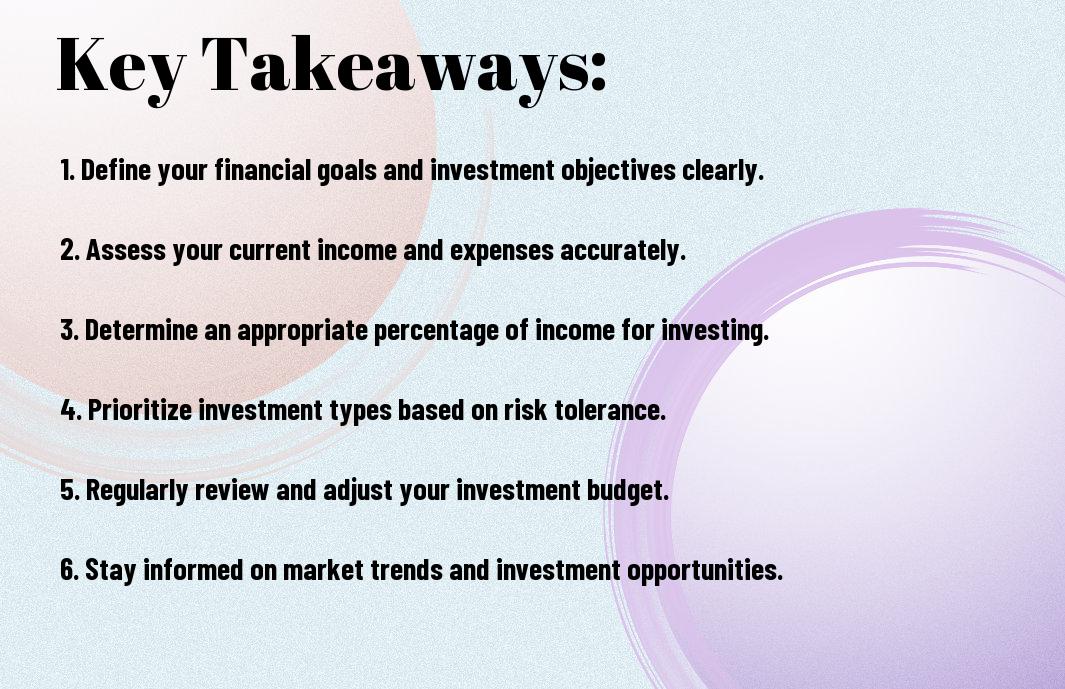With a well-structured investment budget, you can optimize your financial growth and effectively allocate your resources. This guide will walk you through the imperative steps to create an investment budget tailored to your financial goals and risk tolerance. By identifying your income, expenses, and investment priorities, you’ll be equipped to make informed decisions that align with your future aspirations. Let’s look into the process and empower you to take control of your investment journey.
Key Takeaways:
- Assess Your Financial Situation: Analyze your income, expenses, and existing debts to understand your overall financial health before allocating funds for investments.
- Set Clear Investment Goals: Define what you want to achieve with your investments, whether it’s long-term growth, saving for retirement, or generating passive income.
- Determine Your Risk Tolerance: Evaluate how much risk you are willing to take with your investments, as this will influence the types of assets you choose to invest in.
- Allocate a Percentage of Income: Decide on a specific percentage of your income to dedicate to your investment budget to ensure consistent contributions over time.
- Review and Adjust Regularly: Regularly assess your investment budget and adjust it based on changes in your financial situation, market conditions, and personal goals.

Understanding Investment Budgets
As an aspiring investor, understanding investment budgets is vital to your financial planning. An investment budget allows you to allocate funds wisely, enabling you to achieve your financial goals while minimizing risks. By establishing a clear budget, you can differentiate between vital expenditures and potential investment opportunities.
Definition of an Investment Budget
Budget refers to a detailed financial plan that outlines how much money you intend to allocate towards investments over a specific period. It encompasses your income, expenses, and the projected returns from various investment opportunities, ultimately guiding your financial decision-making.
Importance of an Investment Budget
Behind every successful investment strategy is a well-structured investment budget that helps you stay on track. It serves as a roadmap that allows you to manage your finances effectively, ensuring that you invest only what you can afford while pursuing your financial objectives.
The importance of an investment budget cannot be overstated. It helps you assess your risk tolerance, set realistic investment goals, and make informed decisions based on your financial situation. Moreover, having a budget means you can adapt to market changes or unexpected expenses without derailing your investment plans, ultimately leading to long-term financial growth.
Assessing Financial Goals
If you want to create a successful investment budget, it’s vital to assess your financial goals. This first step will help you determine what you hope to achieve through your investments, whether it’s saving for retirement, funding a child’s education, or purchasing a home. By clarifying your objectives, you can make more informed decisions and allocate your resources effectively, allowing you to tailor your investment strategy to meet your unique needs.
Short-term vs Long-term Goals
Above all, you must distinguish between short-term and long-term goals when setting your investment budget. Short-term goals, like building an emergency fund, require liquid assets, while long-term goals, such as retirement or wealth accumulation, can afford more growth-oriented investments. Understanding this difference will guide you in choosing the right investment vehicles and strategies that align with your time horizon.
Risk Tolerance Evaluation
Behind every investment decision lies your risk tolerance, which significantly influences your portfolio’s performance. Assessing your comfort level with risk is vital, as it will dictate the types of investments suitable for you. Consider your time frame, financial situation, and emotional capacity to manage market fluctuations when evaluating your risk tolerance. This self-assessment will help you align your investment choices with your goals and comfort levels.
Another important aspect of evaluating your risk tolerance involves reflecting on your previous experiences with investing. Have you reacted strongly during market downturns, or have you embraced volatility with patience? Your emotional response to risk is a vital indicator of how you might handle future investments. Moreover, consider discussing your risk tolerance with a financial advisor, who can provide insights tailored to your personal circumstances and help you establish a well-balanced investment approach. By understanding your risk appetite, you can create an investment portfolio that not only aims for growth but also aligns with your peace of mind.

Analyzing Current Financial Situation
Once again, it’s crucial to take a comprehensive look at your financial position before plunging into an investment budget. Understanding where you currently stand will help you make informed decisions and identify areas for improvement. This involves a detailed examination of your income, expenses, and overall financial health, enabling you to allocate resources effectively towards your investment goals.
Income and Expense Overview
Above all, documenting your income and expenses is vital for creating an accurate picture of your financial situation. Start by listing all your sources of income, followed by an exhaustive inventory of your monthly expenses. This will allow you to see how much disposable income you have available to invest and help you identify any potential areas for expense reduction.
Net Worth Assessment
The next step is to assess your net worth, which is calculated by subtracting your total liabilities from your total assets. This financial snapshot can help you gauge your financial health and serves as a starting point for your investment strategy.
This assessment allows you to visualize your financial progress and serves as a benchmark for future growth. By calculating your net worth regularly, you can track improvements, set realistic goals, and make adjustments to your investment budget accordingly. If your net worth is positive, you’re on the right track; however, if it’s negative, you’ll want to revise your spending habits and focus on paying down debt before significantly investing.
Allocating Investment Funds
Despite the complexities of investing, allocating your funds wisely is key to achieving your financial goals. Begin by assessing your income, expenses, and savings to determine how much you can invest. For guidance, explore this resource on How can I start budgeting? Learn how to spend, save, and invest. Allocate your investment funds to align with your risk tolerance and investment objectives, ensuring a balanced approach to your financial future.
Strategic Asset Allocation
The strategic asset allocation process involves dividing your investment portfolio among various asset classes, such as stocks, bonds, and cash. By assessing your risk tolerance and investment timeline, you can determine the appropriate percentage of your funds to allocate to each asset class. This structured approach helps to optimize your investment returns while minimizing risk.
Diversification Principles
An effective diversification strategy helps mitigate risk by spreading your investments across different asset classes, sectors, and geographical areas. This approach ensures that your portfolio is not overly dependent on the performance of a single investment or market segment, reducing the potential impact of volatility.
Funds allocated for diversification should span multiple industries and include various asset types, such as equities, fixed income, and real estate. This way, even if one investment underperforms, others may counterbalance the losses, leading to more stable overall performance. Balancing your investments across various categories enables you to take calculated risks while striving for higher returns.
Setting Investment Parameters
Not establishing clear investment parameters can lead to uncertainty and misalignment with your financial goals. You’ll want to align your investment strategy with your overall financial plan, considering aspects such as risk tolerance and expected returns. To better understand how to create a budget, check out How to Create a Budget: Your Guide.
Time Horizon
One of the first steps in setting your investment parameters is determining your time horizon. This is the period during which you expect to hold your investments before needing to access the funds. A longer time horizon allows you to take on more risk, as you have the time to recover from market fluctuations.
Investment Objectives
Above all, you should define your investment objectives clearly. Consider what you hope to achieve, such as saving for retirement, funding your children’s education, or buying a home. This will guide your investment choices and help you prioritize your goals.
Investment objectives vary greatly among individuals and influence your strategy significantly. Whether you’re looking for growth, income, or both, having a well-defined goal helps you select the appropriate assets and techniques to meet your aspirations. Aligning your investment choices with your objectives ensures a more focused and coherent approach to building your wealth.
Monitoring and Adjusting the Investment Budget
Many investors overlook the importance of regularly monitoring and adjusting their investment budget. By consistently evaluating your financial goals and investment performance, you ensure that your budget remains aligned with your financial objectives and market conditions. This proactive approach helps you identify any discrepancies early on, allowing you to make necessary adjustments to maximize your investment potential.
Regular Review Processes
The key to successful investment budgeting is establishing a regular review process. By scheduling weekly or monthly check-ins, you can assess your portfolio’s performance, track your spending, and modify your budget as needed. This disciplined approach not only keeps you informed but also empowers you to make smart, timely decisions regarding your investments.
Adapting to Market Changes
Adapting to market changes is imperative for maintaining an effective investment budget. Shifts in economic conditions, interest rates, or market trends can impact the performance of your investments and necessitate adjustments to your budgetary allocations.
As you stay informed about market changes, you might discover that certain sectors are performing better than others, prompting you to reallocate funds to take advantage of new opportunities. Additionally, unexpected events may impact your financial goals, requiring you to revise your investment strategies. By remaining flexible and responsive to these shifts, you can safeguard your financial future and enhance your investment success.
To wrap up
Drawing together your investment goals, income, and expenses will help you create an effective investment budget. By clearly understanding where your money goes and aligning it with your financial objectives, you can make informed decisions on how to allocate your resources. If you seek further guidance, check out this informative resource on How to start budgeting for investing to enhance your budgeting strategy and optimize your investment approach.
FAQ
Q: What steps should I follow to create an effective investment budget?
A: To create an effective investment budget, start by assessing your financial situation. Review your income, expenses, and savings goals. Next, set clear investment objectives—what you aim to achieve with your investments, such as retirement savings, buying a home, or funding education. Afterward, allocate a portion of your income to investments, considering risk tolerance and time horizon. Lastly, regularly review and adjust your budget to ensure it aligns with your financial goals and market conditions.
Q: How do I determine how much money to allocate to my investment budget?
A: Determining how much money to allocate to your investment budget involves evaluating your expenses and savings needs. Start by calculating your disposable income—this is your income after necessary expenses are covered. A common guideline is to aim to save and invest at least 15% of your income. Ensure you have an emergency fund set aside before investing. It’s also helpful to assess your financial goals and time frames to tailor your investment contributions according to these factors.
Q: What types of investments should I consider when creating an investment budget?
A: When creating an investment budget, consider a mix of investment options that align with your risk tolerance and financial goals. Common investment types include stocks, bonds, mutual funds, and exchange-traded funds (ETFs). You may also explore real estate, retirement accounts like 401(k)s or IRAs, and even alternative investments such as peer-to-peer lending or cryptocurrencies. Diversifying your investments can help balance risks and enhance potential returns, so assess which combinations best fit your strategy.


